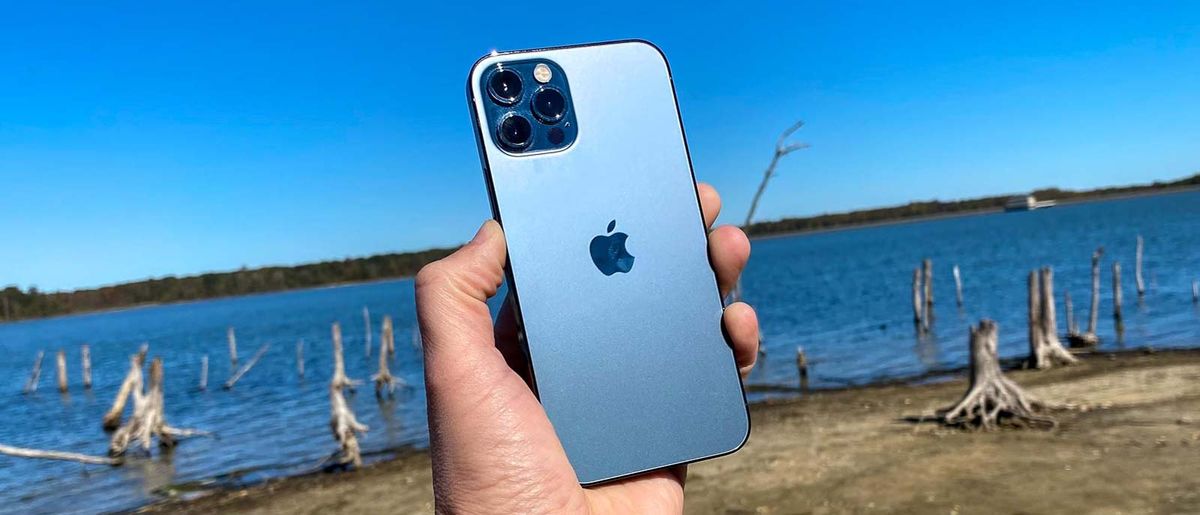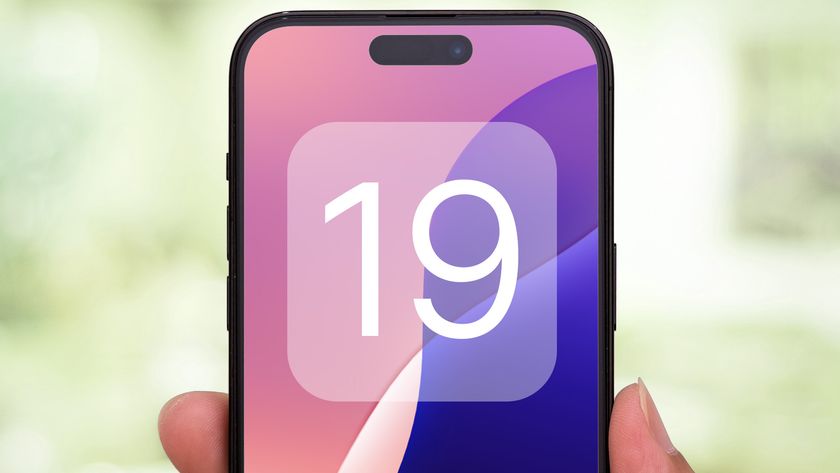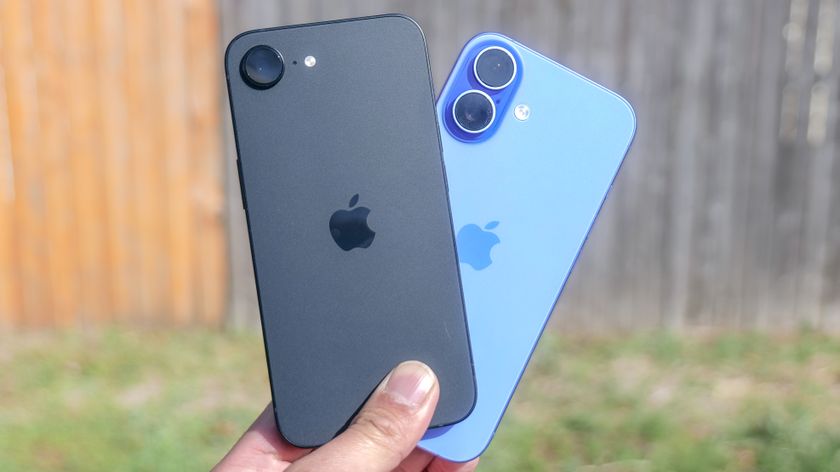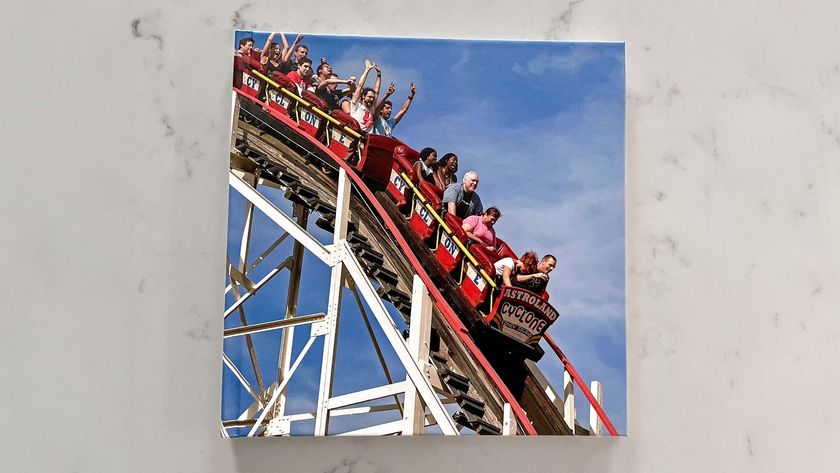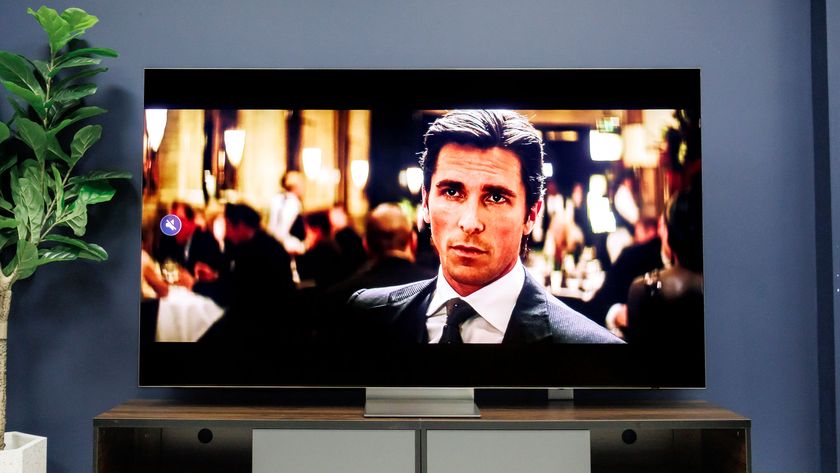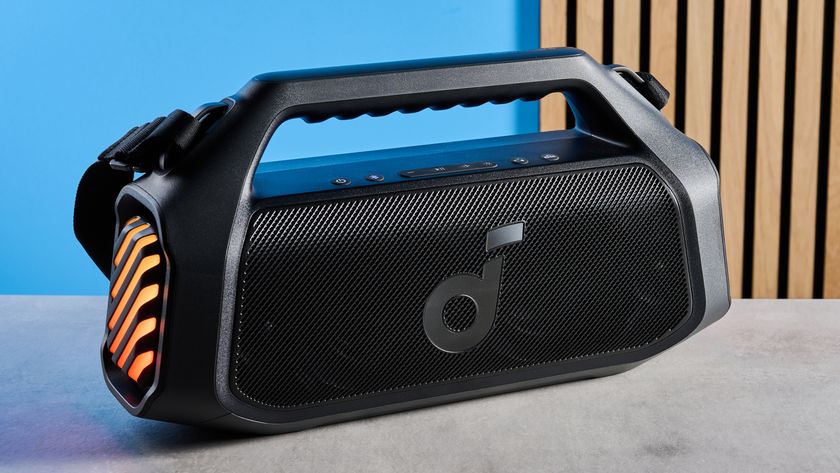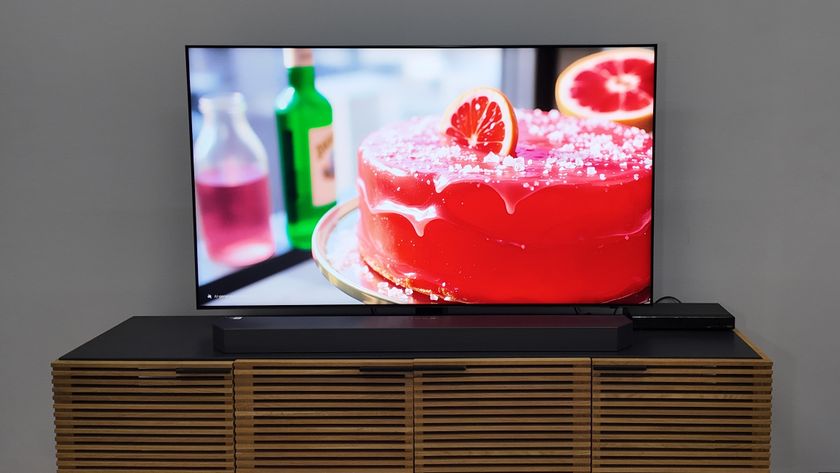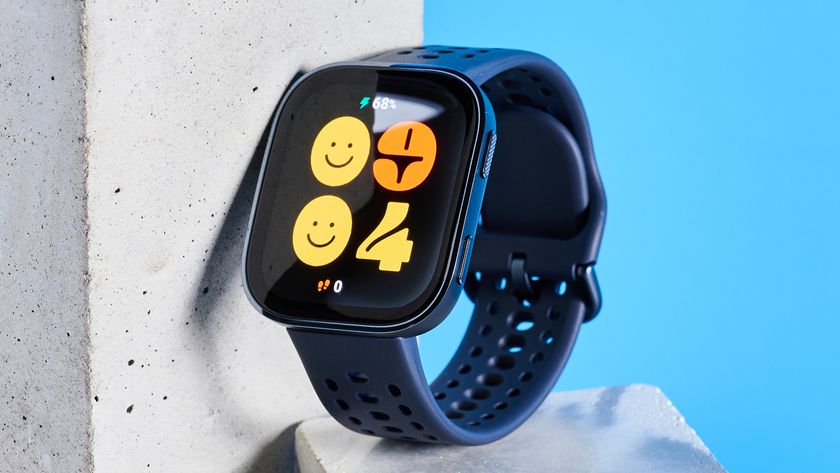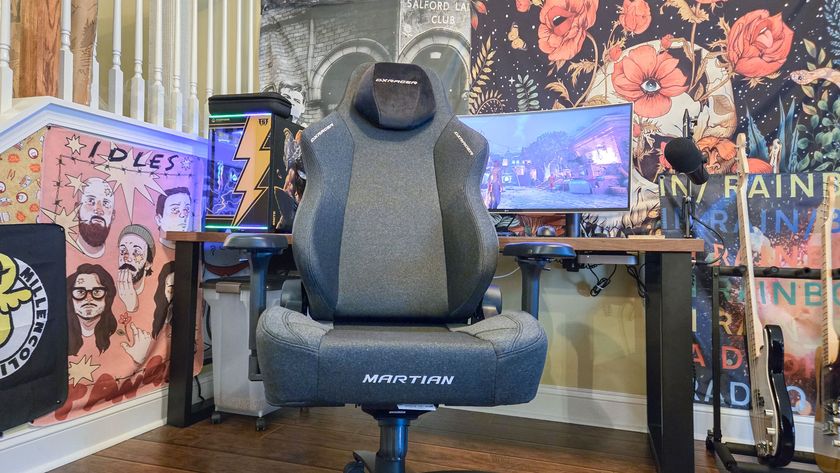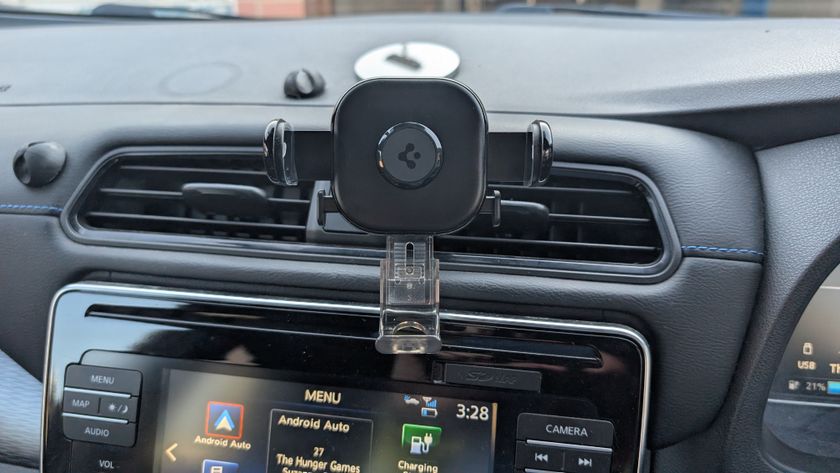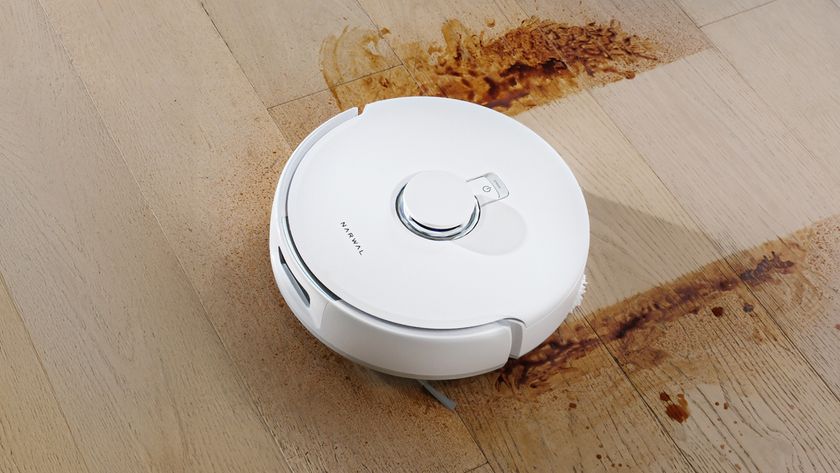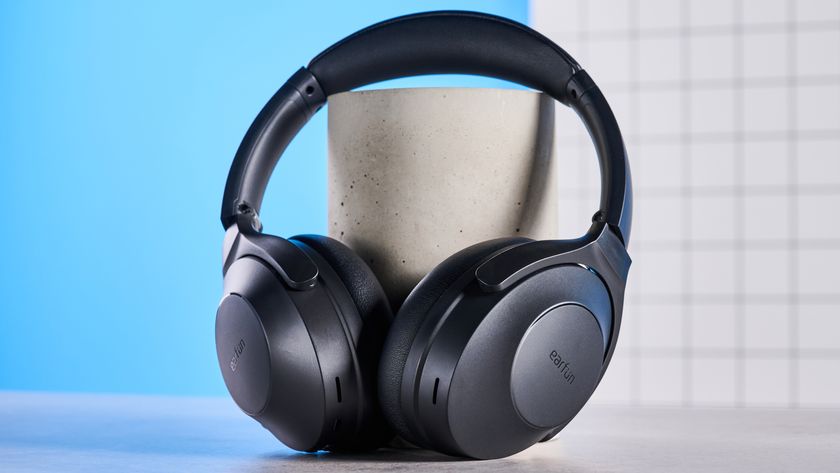Tom's Guide Verdict
The iPhone 12 Pro delivers amazing camera and video quality, 5G and crazy fast performance in a sleeker new design, though the battery life could be better.
Pros
- +
Best-in-class cameras
- +
A14 Bionic blows away Android phones
- +
Tougher Ceramic Shield display
- +
Bigger screen in sleeker design
- +
MagSafe charging is easy to use
Cons
- -
5G takes toll on battery life
- -
No charger in box
- -
Lacks 120Hz display
- -
Limited optical zoom
Why you can trust Tom's Guide
Price: $999, £999
Display: 6.1 inches OLED (2532 x 1170)
Colors: Silver, Graphite, Gold, Pacific Blue
CPU: A14 Bionic
Storage: 128GB, 256GB, 512GB
Rear camera: 12MP wide (f/1.6), 12MP ultra-wide (f/2.4), 12MP telephoto (f/2.0)
Zoom: 2x optical/10x digital
Front camera: 12MP TrueDepth (f/2.2)
Battery: 2,815 mAh
Battery life: 9:06 (5G), 11:24 (4G)
Size: 5.78 x 2.82 x 0.29 inches
Weight: 6.66 ounces
The iPhone 12 Pro represents a big leap, both inside and out. On the inside, there’s fast 5G connectivity and the world’s first 5nm processor that blows away all Android phones. And on the outside, the iPhone 12 Pro is made both tougher with a 6.1-inch Ceramic Shield display and sleeker with a flat-edge design.
But the real reason to get the $999 iPhone 12 Pro over the $799 iPhone 12 or $699 iPhone 12 mini is the cameras. The iPhone 12 Pro offers not only a telephoto lens for optical zoom but a new LiDAR scanner that speeds up autofocus and enables Night mode portraits. Like the other new iPhone 12 models, the iPhone 12 Pro ditches the in-box charger and picks up support for MagSafe wireless charging.
- iPhone 12 Pro Max review: The big-screen champ
- Best unlocked iPhones: Where the iPhone 12 Pro ranks
- The best phones right now
After testing the iPhone 12 Pro, I believe it’s worth the splurge for serious photographers, but heavy 5G use drains the battery quickly. Others may want the iPhone 12 Pro Max, which offers a larger 6.7-inch inch display, even more powerful cameras and longer battery life for $100 more.
While still a fantastic phone that was one of best camera phones around and one of the best phones overall at launch, the iPhone 12 Pro has now been succeeded by the iPhone 13 series, and specifically the iPhone 13 Pro. As a result the 12 Pro has been discontinued. You may still find some new ones knocking around, but retailers' supplies are likely very limited if they have any left at all.
If you're unable to find a 12 Pro on sale, the 13 Pro is probably now your best option since the experience is more refined and the price is identical to the 12 Pro's when it was new. The Samsung Galaxy S21 is a viable Android alternative, which starts at $799 and features a more powerful zoom and 120Hz display. But as you'll see in my iPhone 12 Pro review, it's still a fantastic device even as it enters retirement.
iPhone 12 Pro review: Price and release date
- iPhone 12 release date: Oct 23
- iPhone 12 prices: $999 (128GB), $1,099 (256GB), $1,299 (512GB)
- iPhone 12 U.K. prices: £999 (128GB), £1,099 (256GB), $1,299 (512GB)
- Charger not included and costs extra
The iPhone 12 Pro is widely available after its release last October. The phone starts at $999, which is the same price as the iPhone 11 Pro. However, now you get 128GB of storage, which is double last year’s amount and frankly overdue.
If you want more storage, you can get 256GB for $1,099 and 512GB for $1,299.
Over in the U.K., the iPhone 12 Pro starts at £999 for the 128GB model, then jumps to £1,099 for 256GB of storage, and tops out at £1,299 for the 512GB handset. Bear in mind you can get £280 off the by trading in an older and eligible iPhone.
Keep in mind that Apple does not include a charger in the iPhone 12 Pro box. You get only a USB-C to Lightning cable. If you want to charge the iPhone 12 Pro quickly, a 20W faster charger costs $19. The new MagSafe wireless charger costs $39, which we’ll get into later.
The same is true in Britain, with the MagSafe charger costing £39 and the 20W wired charger coming in at £19.
Check out the best iPhone 12 deals for latest discounts from retailers and carriers. If you buy your iPhone 12 Pro from Apple, you can get up to $525 off the price of your new device by trading in an iPhone 7 or later. (The new the phone, the more the rebate.)
iPhone 12 review: Design and colors
- iPhone 12 trims the bezels (but not the notch)
- Flatter edges look sleek and feels sturdier in hand
- Ceramic Shield glass promises 4x better drop performance
Now this is refreshing. Apple has moved away from the rounded design of the last few iPhones to a flat-edge look on the iPhone 12 Pro. The stainless steel sides feel more solid and less slippery than on the iPhone 11 Pro and are reminiscent of the iPhone 4 (in a good way). The flat edges are sharper than the curvier sides I’m used to, but I didn’t feel any discomfort.
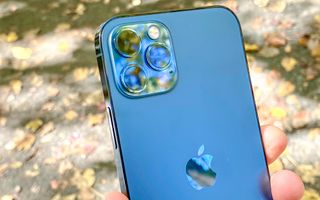
Another plus is that you get a bigger 6.1-inch display in nearly the same size chassis as the 5.8-inch iPhone 11 Pro. That’s because Apple trimmed the bezels around the display. The result is a smartphone with more real estate that’s easier to use with one hand. The iPhone 12 Pro measures 5.78 x 2.82 x 0.29 inches and weighs 6.66 ounces compared to 5.67 x 2.81 x 0.32 inches and 6.63 ounces for the iPhone 11 Pro.
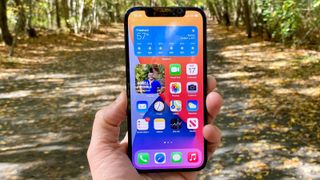
If you’re worried about damage, the front display on the iPhone 12 Pro now uses Ceramic Shield glass, which is rated for four times better drop performance than the iPhone 11 Pro. Apple pulled this off by growing nano-ceramic crystals within the glass matrix. Apple also claims that the back glass is 2x tougher than the iPhone 11 Pro.
We’ll be putting these claims to the test with our own drop tests. However, both the iPhone 12 Pro and iPhone 12 performed exceedingly well in EverythingApplePro's torture test on YouTube. The front glass did not crack at hip or shoulder height when dropped. It took a drop from 10 feet to crack the iPhone 12 Pro's panel.
The iPhone 12 Pro is tough in another way: this phone has a IP68 water resistance rating of 6 meters (19.7 feet), which is considerably deeper than the 2-meter (6.5 feet) rating on the iPhone 11 Pro. In other words, you don’t have to worry if the iPhone 12 Pro takes a dive in the deep end of the pool.
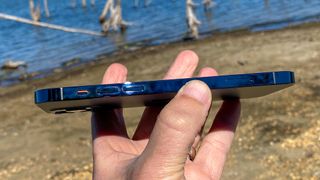
The iPhone 12 Pro comes in four colors: Graphite, Silver, Gold and Pacific Blue. I tested the Pacific Blue model, and I appreciate that the matte glass back did not pick up fingerprints easily.
iPhone 12 Pro review: Display
- Bigger 6.1-inch screen just right compared to 5.8-inch iPhone 11 Pro
- OLED panel is brighter than Galaxy Note 20 Ultra but not as colorful
Yup, the notch is still here on the iPhone 12 Pro, which is not the full-screen experience I was hoping for. But the iPhone 12 Pro does deliver a more immersive viewing experience than the iPhone 11 Pro because of the larger 6.1-inch panel and slimmer bezels.
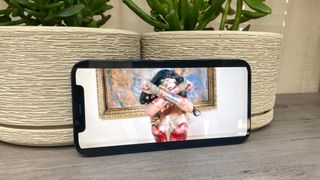
The resolution is slightly higher on the iPhone 12 Pro at 2532 x 1170 pixels and 460 dpi, compared to 2532 x 1170 pixels and 458 ppi for the iPhone 11 Pro.
When watching the trailer for Wonder Woman 1984, the iPhone 12 Pro, her golden bracelets gleamed as she tried to fight off Kristen Wiig’s Cheetah, and the red, white and blue fireworks that exploded around Gal Gadot and Chris Pine really popped.
The iPhone 12 Pro’s panel reproduced 115.6% of the sRGB color gamut and 81.9% of the more demanding DCI-P3 color space. That’s slightly below the Galaxy Note 20 Ultra’s OLED screen in Natural mode (121.5%/86.1%). The Note 20 Ulta’s screen is also a bit more accurate with a Delta-E rating of 0.24, compared to 0.28 for the iPhone 12 Pro.
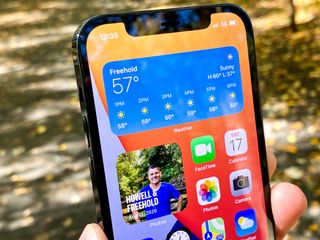
However, the iPhone 12 Pro’s display is brighter, averaging 742 nits on our light meter, compared to 662.7 nits for the Note 20 Ultra. We also found it easier to read the iPhone 12 Pro’s display in direct sunlight.
What the iPhone 12 Pro display doesn’t have that is a fast refresh rate display. The Galaxy Note 20 Ultra, OnePlus 8T and other phones have 120Hz panels that enable smoother animations and faster scrolling. It’s not a deal breaker that this feature is missing from the latest iPhones but it is a bummer.
iPhone 12 Pro review: Cameras
- Larger f/1.6 aperture lets in more light for brighter images
- Night mode works for all cameras now, including selfies
- Better overall image quality than Galaxy Note 20 Ultra but weaker zoom
The iPhone 12 Pro’s photography capabilities are so impressive that it’s almost an insult to call it a camera phone. Although the 12MP resolution remains the same on the wide, ultra-wide and telephoto lenses, there are a ton of upgrades here, starting with a faster f/1.6 aperture for the main camera, which results in 27% improved low-light performance.
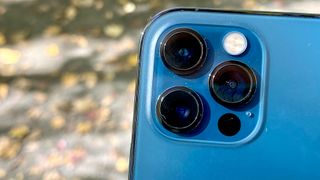
The iPhone 12 Pro’s photography capabilities are so impressive that it’s almost an insult to call it a camera phone.
Other highlights include Night Mode for the Ultra Wide and TrueDepth (front) cameras, Deep Fusion on every camera for better detail and Smart HDR 3 for getting the best results in tricky lightning conditions.
I took a bunch of photos compared to the Galaxy Note 20 Ultra, and the iPhone 12 Pro won nearly every round. Take this shot of some mums and pumpkins on a bench, photographed at daytime in the shadows. The iPhone 12 Pro brings out more details in the pumpkins and especially in the flower petals, resulting in a sharper and brighter image.
The iPhone 12 Pro also outperformed the Galaxy Note 20 Ultra when we tested both cameras at a nearby park. Samsung’s picture is overly bright in the leaves toward the top of the frame and blows out the sky a bit, while the iPhone 12 Pro delivers a deeper blue in the sky and more contrast overall.
I was very impressed with how well the iPhone 12 Pro performed in this portrait. Check out the detail in my brown jacket; you can make out fine stitching even from a distance, which is Apple’s Magic Fusion at work. The Galaxy Note 20 Ultra muddies those details and my face looks overly bright and smooth.
The iPhone 12 Pro does have a camera weakness, and that’s zoom. You get only 2x optical zoom, compared to 5x for the Note 20 Ultra. Check out the difference with both phones set to 10x digital zoom. The wood sign looks a lot blurrier on the iPhone 12 Pro’s shot, as does the grass and garbage can in the background. And the Note 20 Ultra can go much further than this, all the way out to 50x.
The iPhone 12 Pro and Note 20 Ultra were pretty evenly matched in this shot of produce. Both images are sharp, but the highlights in the peppers on Samsung’s pic are more pleasing to the eye. The tomatoes in the background, though, look richer on the iPhone 12 Pro.
The Night Mode on the iPhone 12 Pro is improved because it’s now available on the Ultra Wide camera as well as the telephoto and wide lenses. And I found that the iPhone 12 Pro captured Night Mode images more quickly than on the iPhone 11 Pro.

When snapping a photo of a glass pumpkin next to a candle in close to complete darkness, the iPhone 12 Pro took 3 seconds, compared to 6 seconds for the Note 20 Ultra. That’s a much longer time to hold the camera still. However, while the iPhone’s shot is brighter, it’s also grainier.
The TrueDepth camera on the iPhone 12 Pro gets a big upgrade with Night Mode. It will turn on automatically when you don’t have enough light, and I noticed a big difference. In this selfie, taken in a room at dusk with no other lights on (other than my computer monitor), the iPhone 12 Pro captured a much brighter image. You can make out more details in face and hair, as well as in my blue blue-and-gray shirt.
If you really want more creative freedom, the iPhone 12 Pro will get support for Apple ProRAW later this year, which will let you shoot in RAW format. This deep image file will be editable in the Photos app and other professional photo apps.
iPhone 12 Pro review: Video
- Dolby Vision HDR delivers the most colorful footage on a phone
- Faster aperture results in better looking video in low light
The iPhone 12 Pro is the world’s first phone that can shoot footage in HDR with Dolby Vision support. That means this handset can capture up to 700 million colors when recording videos. And the frame rate goes up to 60 fps in 4K. In addition, you can watch and edit the Dolby Vision HDR video you shoot right on the iPhone 12 Pro.
I was blown away by the footage the iPhone 12 captured near the shore of the Manasquan river. Right from the opening frame, I could make out the gradations of color in the sky, and the green moss on the left side of the path and the leaves as I panned up looked more vibrant than with the Note 20 Ultra’s camera.
Another perk is that the iPhone 12 Pro’s larger aperture delivers better low-light video recording. And you can capture Night mode Time-lapses for dramatic looking footage — provided you use a tripod.
To test out the iPhone 12 Pro’s low-light video recording, I captured some 4K footage at 60 fps in my front yard as the sun was coming up. The iPhone’s video looked brighter and sharper in the pathway, pumpkins and especially the yellow mums.
iPhone 12 Pro review: 5G
- It supports the most 5G bands, but the fastest speeds are in limited areas
- Smart Data Mode can help save battery life
The iPhone 12 Pro supports all the varieties of 5G, including sub-6GHz, mmWave and upcoming mid-band frequencies being rolled out by various carriers. The benefit of 5G is that you can enjoy faster downloads, as well as lower latency when playing games or when running real-time apps like augmented reality experiences.
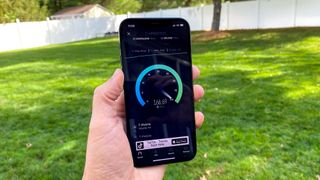
Apple adds on to the 5G experience in a couple of ways. Smart Data Mode can automatically switch from 5G to 4G LTE to save you battery life, such as when you’re streaming music with the screen off. You can also conduct full-HD FaceTime calls over 5G, which you couldn’t do before.
In our testing over T-Mobile’s network, the iPhone 12 Pro topped out at 177 Mbps for downloads and 26.9 Mbps for uploads. Those speeds are okay, but they’re not much better than 4G LTE. If you want 2 Gbps speeds, your best best is Verizon’s 5G network right now, which has high-speed mmWave deployed in 51 cities and counting. Buy you’ll need to be in line of sight to a nearby node. (Verizon’s nationwide 5G network just went live in 1,800 cities, but speeds there aren’t as fast as mmWave.)
iPhone 12 Pro review: Performance
- The A14 Bionic processor is the performance champ once again
- iPhone 12 beats fastest Android in multiple tests
As the world’s first 5nm chip in a handset, Apple claims that the iPhone 12 Pro has the fastest chip in a smartphone. Benchmarks and our own real-world tests back up that claim. In fact, Apple is just widening the gap at this point between the iPhone and Android phones.
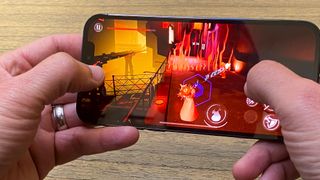
We transcoded a 4K video to 1080p in Adobe Premiere Rush app, and it took the iPhone 12 only 27 seconds. The Galaxy Note 20 Ultra was way behind at 1 minute and 16 seconds. The iPhone 11 Pro took 46 seconds.
The iPhone 12 Pro also provided swift performance when playing Samurai Jack from Apple Arcade. Even with more than a dozen enemies on screen, the gameplay didn’t stutter as I threw ninja stars and swung my sword in every direction.
On Geekbench 5, which measures overall performance, the iPhone 12 Pro scored 1,595 on the single-core test and 3,880 on the multi-core test. By comparison, the Galaxy Note 20 Ultra’s Snapdragon 865 Plus chip scored 985 and 3294, respectively. The Asus Rog Phone 3, one of the most powerful Android phones we’ve reviewed, hit 3,393 on the multi-core test.
To test the graphics performance on the iPhone 12 Pro, we ran the new 3DMark Wild Life benchmarks. It measures GPU performance by rendering demanding game scenes in real time. The iPhone 12 Pro scored 6,567 and 39 fps, compared to 4,164 and 24.9 fps for the Note 20 Ultra.
We have a more in-depth iPhone 12 Pro benchmarks results comparison if you want to see how the iPhone 12 Pro compares to other phones and the previous iPhone 11 Pro..
iPhone 12 Pro review: Battery life
- The iPhone 12 Pro battery life is 2.5 hours shorter over 5G than 4G
- Smart Data mode can help save power
The iPhone 12 Pro includes a 2,815 mAh battery, which is smaller than the 3,046 mAh battery in the iPhone 11 Pro. Overall, we saw pretty good battery life in day-to-day use, but 5G can take a serious toll.
On the Tom’s Guide battery test, which involves surfing the web at 150 nits of screen brightness over cellular, the iPhone 12 Pro lasted 9 hours and 6 minutes on T-Mobile’s 5G network. The similarly priced Galaxy Note 20 lasted 9 hours and 38 minutes over AT&T’s 5G network.
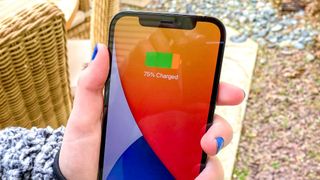
When we switched over to 4G, the iPhone 12 Pro lasted a much longer 11 hours and 24 minutes. The handsets on our best phone battery life list all last more than 11 hours, but you shouldn’t have to toggle between 5G and 4G to get there. By comparison, the iPhone 11 Pro lasted 10:24 over 4G, but that had a smaller 5.8-inch display and (presumably) a smaller battery.
We have a more in-depth iPhone 12 Pro battery life comparison with the iPhone 12 and other Android phones if you want to check it out.
The iPhone 12 Pro can help you save battery life when you’re not surfing the web. A Smart Data mode can toggle switch between 5G and 4G automatically under certain conditions, such as when you’re streaming music with the screen turned off.
iPhone 12 Pro review: Charging and MagSafe
- Apple doesn’t ship a charger for environmental reasons
- MagSafe is easy to use wireless charging but is relatively slow
Alas, Apple did not include a charger in the box with the iPhone 12 Pro in an effort to be more environmentally friendly. I get it — there are millions of existing charging bricks out there. But if you want the fastest possible charging speeds, you’re going to have to pay an extra $19 for a 20W charger, promising 50% capacity in 30 minutes.
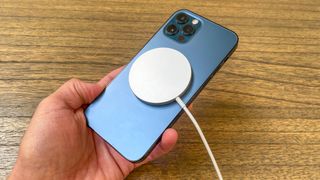
The iPhone 12 is behind the Android competition here. Samsung supports 25W charging on the Note 20 Ultra and 45W charging on the Galaxy S20 Ultra. And the OnePlus 65T does 65W charging.
To take the guesswork out of wireless charging, Apple has introduced MagSafe for the iPhone 12 Pro and other new iPhone 12 models. Because the iPhone 12 Pro has magnets built into its back, the MagSafe charger ($39) easily snaps onto the phone and starts charging. This charger delivers 15W of power, taking the iPhone 12 Pro to just 39% in 30 minutes.
There is a side benefit to MagSafe, and that’s the fact that you don’t have to deal with the Lightning connector, which can stop working properly over time. However, we found the charging to be slow. After 30 minutes, the iPhone 12 Pro got to just 31% capacity with MagSafe, and it took 52 minutes to get to 50%.
There are MagSafe-ready cases available for the iPhone 12 Pro as well, and a MagSafe wallet you can snap on the back of your iPhone if you want to carry real credit cards and cash to complement Apple Pay.
We don't recommend the $129 Apple MagSafe Duo. While it charges the iPhone 12 Pro and an Apple Watch simultaneously, it does so only at 11W when paired with a 20W charger. And even if you spring for a 30-watt charger, the iPhone 12 Pro will max out at 14W.
iPhone 12 Pro vs Samsung Galaxy S21
The iPhone 12 faces stiff competition from the Samsung Galaxy S21, which features a dynamic 6.2-inch AMOLED display with a 120Hz refresh rate and longer battery life. Plus, the S21 offers a more powerful 30x digital zoom. However, the iPhone 12 Pro offers faster performance, a more premium glass design (the S21 is plastic) and better image quality.
iPhone 12 Pro review: Verdict
The iPhone 12 Pro is a serious step up from the iPhone 11 Pro, but that’s not who this flagship is really for. It’s for those who own older iPhones who are looking to upgrade, such as the iPhone XS, iPhone X or iPhone 8. You get a bigger display in a design that’s just as compact, cameras that deliver astonishingly good results (especially in low light) and 5G connectivity.
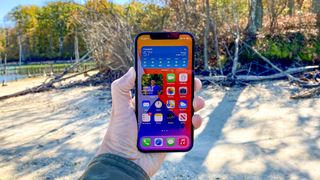
At this stage, fast 5G is not widespread, so you may not enjoy home-broadband-like speeds in your neck of the woods for some time. And even when you can get it, 5G can take a serious hit on the iPhone 12 Pro’s battery life. I’d like to see Apple get even more aggressive with its Smart Data mode to squeeze out more juice.
The iPhone 12 Pro gives you double the storage in the regular iPhone 12, as well as its optical zoom and better auto-focus, and for me the $200 premium is well worth it. However, those who prefer a larger display should definitely check out the 6.7-inch iPhone 12 Pro Max. Overall, the iPhone 12 Pro beats every Android phone in its class in terms of performance and camera quality, even if it’s a step behind in battery life.
Mark Spoonauer is the global editor in chief of Tom's Guide and has covered technology for over 20 years. In addition to overseeing the direction of Tom's Guide, Mark specializes in covering all things mobile, having reviewed dozens of smartphones and other gadgets. He has spoken at key industry events and appears regularly on TV to discuss the latest trends, including Cheddar, Fox Business and other outlets. Mark was previously editor in chief of Laptop Mag, and his work has appeared in Wired, Popular Science and Inc. Follow him on Twitter at @mspoonauer.
-
N. Ringheim I am sure it has a really good camera, I'm not sure if it is industry leading, let's trust professionals like Doxmark to test it. I am pretty sure that old camera phone leaders like Huawei p40 pro+ or the new Mate 40 is going to give it some stiff competition. But apple is good at making video recordings. But let's just hold on to all the superlatives like "best" ,"greatest", "industry leading" etc. I know they like to use it in their marketing material, but journalism is about looking past all the hype, or else we could just stop reading tech magazines and stick to the marketing brochure. But just my opinion.Reply
